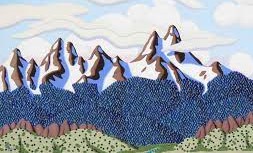
The Hazards of Distraction
To be close to family, my wife, Amparo, and I recently moved from Iowa to Colorado, and I’ve been soaking up the natural beauty here.
About five minutes from our house, in fact, is a park where you can see an incredible view of the whole “front range,” from Pike’s Peak south to Long’s Peak north with a beautiful, lush valley in between. I doubt if there’s a sweeter view in all of the Denver area.
Iowa is beautiful, too, of course. It just has a different kind of beauty.
I’ve been thinking about how many people fail to notice nature’s attractions. We are so tuned in to day-to-day projects and problems, so attentive to what’s on our smart phones, computers and TVs, we often miss what’s really important.
What We Miss Seeing
In a recent article in the New York Times, Tish Harrison Warren, an Episcopalian priest, quotes author Andrew Sullivan, who writes: “With that power comes a temptation, like never before, to miss seeing our own city park, our own block, our own yard, and the faces around our own kitchen tables.”
Writes Harrison Warren: “My backyard does not move at the pace of YouTube. It is not as bright as (virtual reality). It does not buzz my pocket with notifications or headlines. It extends a quiet, complex blessing and leaves it up to me to receive it or not.”
The contemporary world, I believe, is awash in distractions from what counts in life, including our search for God.
And it’s not just electronics that is the problem. Life has become so complex that attention to nature, to the spiritual, to prayer, seem trivial. How do we get our kids to school on time when the boss schedules a “must attend” online meeting at that hour? How do I get an urgent plumbing problem fixed when we’re short of cash? How can I start a new business when no institution is willing to loan me money?
And many of the problems that distract us can be much less urgent.
Centering Prayer
For almost a year, I’ve been practicing “centering prayer.” A form of meditation, it basically involves 20 minutes (Twice a day is recommended, but so far I can only manage once a day.) of trying to clear the mind of everything, of relaxing and emptying self to allow God more fully into my life.
It’s surprising to me how hard it is to “think of nothing.” One problem-solving issue after another enters my mind, and being retired with only grown children, I have no major problems to solve. But that’s how the mind works – always trying to solve problems – sometimes problems that don’t really exist – and trying to predict what the future holds.
But in my view, one of the biggest problems for modern people is the kind of chronic distraction that delays attempts to find answers to the major life questions: Who is God? Where is God? What does he/she have to do with my life? This kind of distraction can last for years, keeping us from confronting those issues.
Ah, you might say, but there are no answers to those questions so why waste time on them. But are we sure about that? Are the efforts and witness of millions, perhaps billions, of religious people over thousands of years simply a waste of time? Are the distractions that keep us from considering these questions really more relevant?
Cultural and Spiritual Backgrounds
Obviously, the approach to these and many questions about God and the meaning of life depends on our cultural and spiritual backgrounds. But the major religions, including my own Catholic faith, have answers that are at least as relevant and helpful as, say, science, which is unable to answer questions such as “Why something instead of nothing?” “How did the universe begin?” (The big bang presumes the existence of matter.)
I believe that natural beauty provides one approach to answering the great life questions. Noticing and appreciating it is a good start. Even though nature is not flawless, asking how such beauty and order occurs, questioning the total randomness suggested by science, is another step in the right direction.
Contrary to current popular belief, it’s possible that God has something to do with the natural beauty in Colorado, and in Iowa.



